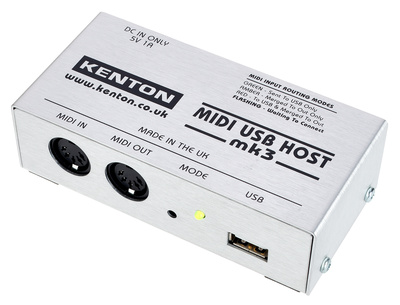

Whichever channel it detects first − from Host or Device − is the assigned channel (if your kit is dishing out ALL channels, Mini MIDI will pick the first one… which is 1).

On powering up, Mini MIDI sits patiently waiting for a MIDI signal. In the end we used ‘first come, first served’.

(Far left, BTW, because then you can use angled USB connectors and avoid thick cables trailing all over your rack… ). A front panel selector would increase the size of a module that′s designed to be squeezed into the far left of your rack. DIP switches are wildly impractical, as you often need to change MIDI channels. We thought hard about MIDI channel assignment. USB Host is the heart of Mini MIDI, bridging the gap between your modular system and a MIDI host device, such as a DAW or hardware MIDI sequencer. 22mA + current consumption of a connected class compliant USB Device, USB current supply available up to 500mA USB MIDI Host Interface output current: up to 500 mAģU Eurorack module, 4 HP wide, compatible with Skiff cases USB Device lets you connect… wait for it… a USB MIDI device! An obvious use is when you want to use your favourite, gig-friendly, USB controller on stage to control that cut-off, thus keeping your real-estate-guzzling modular rack out of the way (and out of reach of that beer you have perched on a cheap M-Audio controller). If this is you, you won′t be disappointed. Start(stop) and Clock offer no surprises, but if you have a sequencer in your rack you aren′t looking for surprises, just a way to trigger it and keep it in time from your DAW and other kit. The remaining three DIP settings access three additional modes: Note Velocity and Aftertouch modes convert those signals to CV, while Calibration allows precise setting of scale and pitch offset. You can select from 13 different CC values (if you′re superstitious then Mini MIDI is not for you). The CC value to be converted is set using rear panel DIP switches, allowing multiple Mini MIDIs to respond to different CC values from the same DAW / instrument source. Pitch and Gate are self-explanatory, taking MIDI note information (pitch and note-on/off) from your DAW / keyboard / keytar / USB-whatever, and turning it into something your modular oscillators understand.ĬC receives note velocity, aftertouch, or continuous controller information from USB and spits out modular-friendly CV, ready to command anything from filter cut-off to LFO rate. Nevertheless, this simple, space-saving format contains no less than seven connections: Pitch, Gate, CC, Start, Clock, USB Device, USB Host. Mini MIDI draws aesthetic inspiration from a runway model… or a drumstick… or the Taipei 101. We love the power and creativity of DAWs, so we′ve long dreamed of a module to bridge the gap between our computer, modular system, and USB MIDI devices. We love analogue hardware, and we also love the power and creativity of DAWs. With over 20+ modules and three complete modular systems in our portfolio, you′d be forgiven for thinking we′re a bunch of purists, roaming the studios of Berlin by night, looking for unsuspecting copies of Ableton Live and Cubase to infect with viruses.īut nothing could be further from the truth. Want to connect your modular system to USB MIDI equipment or computer-based DAWs? Simultaneously? We did too.


 0 kommentar(er)
0 kommentar(er)
